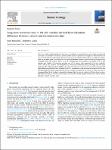Long-term accretion rates in UK salt marshes derived from elevation difference between natural and reclaimed marshes
| dc.contributor.author | Masselink, G | |
| dc.contributor.author | Jones, RB | |
| dc.date.accessioned | 2024-01-24T11:03:09Z | |
| dc.date.available | 2024-01-24T11:03:09Z | |
| dc.date.issued | 2024-01 | |
| dc.identifier.issn | 0025-3227 | |
| dc.identifier.issn | 1872-6151 | |
| dc.identifier.other | 107202 | |
| dc.identifier.uri | https://pearl.plymouth.ac.uk/handle/10026.1/21938 | |
| dc.description.abstract |
The future of salt marshes depends in a large part on the balance between the future rate of marsh accretion and the future rate of sea-level rise (SLR). Current accretion rates can provide some insight into future resilience of salt marshes to SLR, but representative long-term rates across the complete salt marsh area are difficult to obtain. Here, we introduce a new method based on the elevation difference between a natural marsh and a neighbouring reclaimed marsh. The method, referred to as the ‘reclaimed salt marsh method’, was applied to 19 UK salt marshes and yielded a UK-averaged accretion rate of 4.5 mm/yr with considerable inter-site variability (0.68–7.88 mm/yr). Accretion rates were positively correlated with the mean spring tide range, with tide range explaining 37% of the inter-site variability in accretion rate. Observed accretion rates were found to be generally larger than that predicted for SLR according to RCP2.5, comparable to that predicted according to RCP4.5 and less than that predicted according to RCP8.5. However, future accretion rates are unlikely to remain the same. It is suggested that UK salt marshes in macrotidal settings are likely to be more resilient to SLR than those in micro- and meso-tidal settings. The reclaimed salt marsh method can be readily applied to other sites to obtain a global data base of marsh accretion rates. | |
| dc.format.extent | 107202-107202 | |
| dc.language | en | |
| dc.publisher | Elsevier BV | |
| dc.subject | Salt marsh | |
| dc.subject | Sea -level rise | |
| dc.subject | Vertical accretion | |
| dc.subject | Reclamation | |
| dc.title | Long-term accretion rates in UK salt marshes derived from elevation difference between natural and reclaimed marshes | |
| dc.type | journal-article | |
| dc.type | Article | |
| plymouth.volume | 467 | |
| plymouth.publication-status | Published | |
| plymouth.journal | Marine Geology | |
| dc.identifier.doi | 10.1016/j.margeo.2023.107202 | |
| plymouth.organisational-group | |Plymouth | |
| plymouth.organisational-group | |Plymouth|Research Groups | |
| plymouth.organisational-group | |Plymouth|Faculty of Science and Engineering | |
| plymouth.organisational-group | |Plymouth|Faculty of Science and Engineering|School of Biological and Marine Sciences | |
| plymouth.organisational-group | |Plymouth|Research Groups|Marine Institute | |
| plymouth.organisational-group | |Plymouth|REF 2021 Researchers by UoA | |
| plymouth.organisational-group | |Plymouth|Users by role | |
| plymouth.organisational-group | |Plymouth|Users by role|Academics | |
| plymouth.organisational-group | |Plymouth|REF 2021 Researchers by UoA|UoA07 Earth Systems and Environmental Sciences | |
| plymouth.organisational-group | |Plymouth|Users by role|Researchers in ResearchFish submission | |
| plymouth.organisational-group | |Plymouth|REF 2028 Researchers by UoA | |
| plymouth.organisational-group | |Plymouth|REF 2028 Researchers by UoA|UoA07 Earth Systems and Environmental Sciences | |
| dcterms.dateAccepted | 2023-12-04 | |
| dc.date.updated | 2024-01-24T11:03:09Z | |
| dc.rights.embargodate | 2024-1-27 | |
| dc.identifier.eissn | 1872-6151 | |
| rioxxterms.versionofrecord | 10.1016/j.margeo.2023.107202 |


